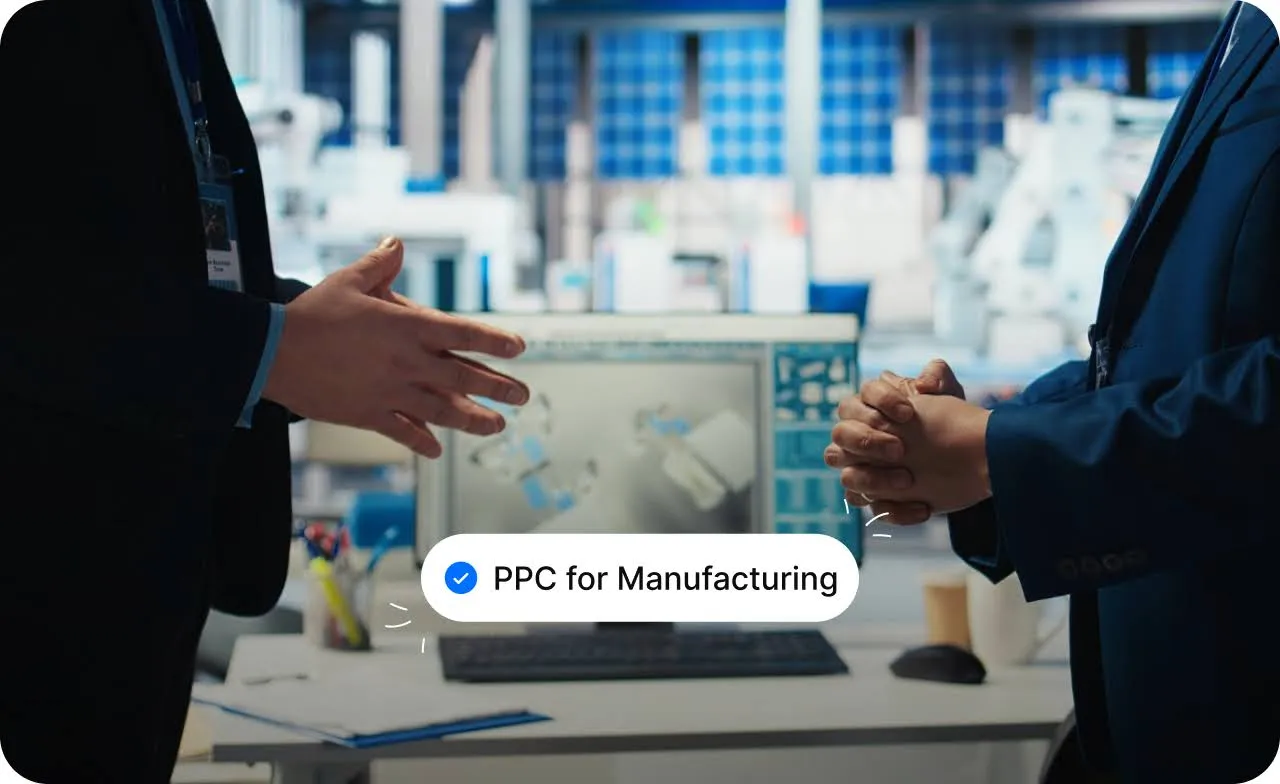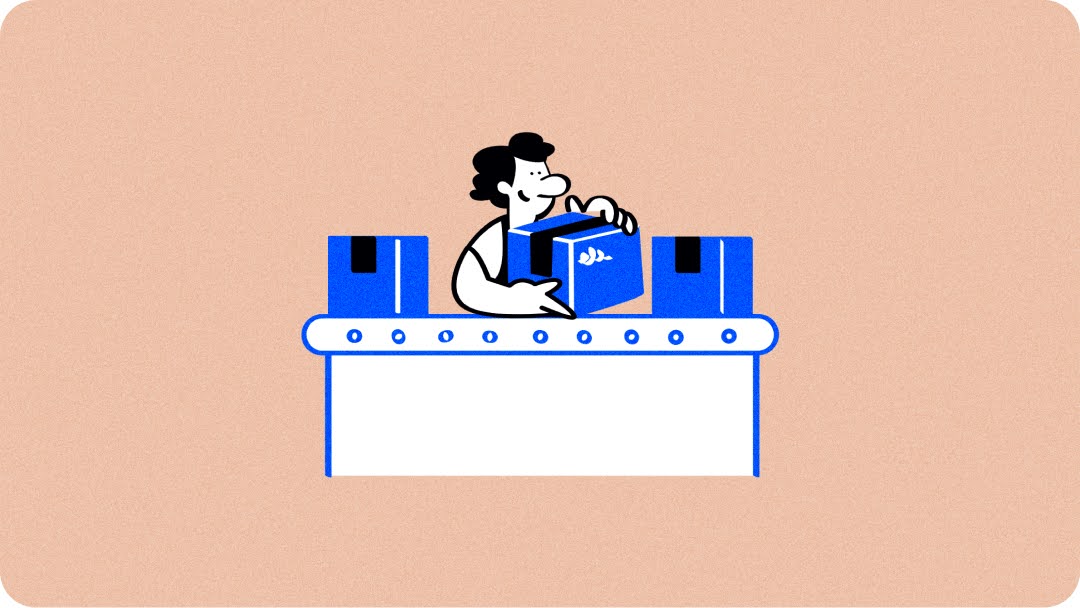If you run a manufacturing business, you’ve likely had the same thought at some point: “We make good products. Why aren’t more qualified buyers finding us?”
Many manufacturers deliver solid work, meet deadlines, and keep customers happy, but still struggle to get steady inquiries from the right kind of buyers.
Trade shows help. Referrals help. But neither gives you predictable, year-round leads.
That’s where PPC for manufacturing becomes a game-changer. PPC is a simple tool that gets your business in front of buyers at the exact moment they search for what you produce. PPC pushes your company to the top. You only pay when someone clicks, so every dollar goes toward real interest.
In this blog, you’ll learn how PPC works, why it’s one of the smartest ways for manufacturers to get qualified leads, and how to run it without wasting money.
What Is PPC for Manufacturing?
PPC for manufacturing is simply a paid way to get your business in front of serious buyers at the exact moment they’re looking. But instead of thinking about “ads,” think of it like this:
You’re paying to skip the line.
When buyers search online for a supplier, Google sorts through hundreds of businesses. PPC lets you jump to the front so buyers see you first. You should know: PPC is not about “branding” or “awareness” or chasing clicks.
For manufacturers, PPC is about catching purchase intent.
Purchase intent is when a buyer searches with a real need in hand, like:
- “ISO-certified sheet metal fabricator near me”
- “Custom injection molding supplier small batch”
- “HVAC coil manufacturer bulk order”
- “Precision machining for stainless steel”
These searches are signals that someone is sourcing, pricing, or ready to buy.
You only pay when someone actually clicks your ad.
No click = no charge.
So instead of paying for billboards, trade shows, or magazine ads hoping the right person sees it, a PPC strategy for manufacturers lets you pay only when an actual buyer takes action.
Why PPC Is Especially Useful In Manufacturing?
Unlike retail businesses, manufacturers deal with:
- long buying cycles
- technical products
- multiple decision-makers
- low-volume but high-value orders
PPC helps in fixing a visibility problem that your competitors are already working on.
The moment your campaign goes live, your business starts appearing in front of active buyers. And you can increase or decrease the flow anytime based on capacity, season, or demand.
This makes PPC ideal for manufacturers trying to grow their pipeline, reach new markets, or stabilize lead flow when deals slow down.
How to Build a PPC Campaign That Brings Manufacturing Leads?
Running a successful PPC campaign in manufacturing is all about focusing on quality over quantity. While it may be tempting to go for broad, high-traffic keywords, these often attract unqualified leads who aren’t ready to make a purchase.
Instead, it's crucial to hone in on specific, intent-driven keywords that align with your core products and services. A well-structured PPC campaign will target the decision-makers in your industry, ensuring every click brings you one step closer to securing a lead.
Let’s dive into the blueprint that will help you set up PPC campaigns that actually convert, starting with the critical element of keyword targeting.
Break Free from Broad Keywords, Focus on What Matters
Broad keywords like “machinery” or “manufacturing” are often too vague and can waste your advertising budget. While these keywords may attract a lot of clicks, they don’t always translate into valuable leads.

Instead, focus on long-tail keywords that are much more specific to your business and industry.
These types of keywords reflect specific processes, materials, and industries that are directly relevant to your target audience.

Benefits of Focusing on Long-Tail Keywords:
- Lower CPC: Long-tail keywords generally have less competition, leading to lower costs per click.
- Higher conversion rates: Because the searcher is more likely to be looking for exactly what you offer, the chance of converting them into a lead is significantly higher.
- More qualified traffic: You’re attracting users who are further down the funnel and ready to engage with your brand.
Tip: Avoid broad, generic terms like “machinery” or “manufacturing,” as they will quickly eat through your budget without bringing in qualified leads. Instead, focus on the unique capabilities and specializations that set your business apart.
Define Goals That Matter
One of the biggest mistakes manufacturers make in PPC is focusing solely on click-through rates (CTR) or impressions. While these metrics are important for gauging the visibility of your ads, they don’t tell you how well your ads are actually driving business results.
Instead of focusing on vanity metrics, set real business goals that align with your sales process and track meaningful conversions. For manufacturers, some of the most important goals to track include:
- Cost per Qualified Lead (CPL): Measure the cost it takes to bring in a qualified lead that could potentially convert into a customer. This is a more accurate reflection of your ad spend's effectiveness.
- Quote Requests: Track how many people click on your ads and then fill out a form or request a quote. This is a clear sign of intent and a more valuable conversion metric for manufacturers.
- Conversion Rates: Ultimately, the goal of any PPC campaign is to convert clicks into real customers. Focus on the percentage of people who take action after clicking your ad, whether it's requesting more information, scheduling a call, or purchasing.

Why This Metric Matters?
Focusing on conversion-based goals, such as CPL and conversion rates, provides a clearer picture of your campaign's effectiveness.
How to Set and Track Effective PPC Goals:
- Define what success looks like: For example, a quote request or download is much more actionable than just a click.
- Use conversion tracking: Implement tools like Google Tag Manager and Google Analytics 4 (GA4) to track all interactions that contribute to your end goal.
- Measure ROI, not just CTR: Focus on how your ad spend translates into actual business outcomes. Tools like Google Ads Conversion Tracking and CRM software can help you connect ad clicks to offline purchases or leads.
Tip: Align your goals with your sales funnel, measure the actions that indicate genuine interest and are most likely to convert into a sale.
Essential PPC Optimizations Every Manufacturer Should Use
When it comes to PPC campaigns for manufacturers, success isn’t just about choosing the right keywords or setting a solid budget. Every detail matters, from the words in your ads to the layout of your landing pages.
Small tweaks can make the difference between a click and a conversion.
Let’s break down the key elements that can optimize your campaigns and turn them into lead-generating machines.
Your Ad Copy Should Speak Their Language
Think of your ad copy as the handshake with your potential customers. It needs to be clear, direct, and reflect the specific needs of your target audience. Generic ad copy, like "high-quality parts," doesn’t tell your audience why they should care. Instead, use precise language that highlights your unique selling points.
This type of copy speaks directly to your customers' needs and gives them exact details they care about, certifications, materials, and specifications. It also builds trust quickly because it shows you understand their industry and requirements.
Why Precision in Ad Copy Matters:
- Builds trust: Highlighting certifications and precise details makes your business appear professional and reliable.
- Speaks directly to decision-makers: Use industry-specific terms that resonate with your audience, engineers, procurement managers, etc.
- Increases conversion chances: Specifics like material specs and certifications can lower bounce rates by aligning with your customers’ exact needs.
A Landing Page That Does the Selling For You
Your landing page is where the magic happens. It’s the place where a potential customer goes from curious to committed. But here’s the key: simplicity and focus are your best friends. When a user clicks on your ad, they’re expecting something very specific. Make it easy for them to act.
Here’s how to do it:
- One Action: Whether it’s “Request a Quote” or “Download our Capabilities PDF”, keep the focus on a single call to action (CTA). Avoid overwhelming the visitor with multiple options that can lead to decision fatigue.
- Minimal Distractions: Ensure your landing page has a clean design, clear headings, and a logical flow. Too many images, links, or unnecessary information can distract decision-makers from taking the desired action.
- Show Your Value Quickly: The moment the user lands on your page, they should immediately see the benefits, be it your quality certifications, unique selling points, or customer testimonials. Your page should clearly highlight what sets your business apart.
Best Practices for Landing Pages:
- Highlight the offer immediately: Whether it's a quote or PDF, it should be front and center.
- Keep it concise: Show only what's needed to push the visitor toward conversion.
- Trust signals: Add badges, certifications, and customer logos to build credibility right away.
- Speed: Fast-loading pages are crucial. A 1-second delay in loading can reduce conversions by 7% (Google Research, 2023).
The goal of your landing page is to convert visitors into qualified leads, and by focusing on simplicity and clarity, you're much more likely to get the results you're looking for.
Best Ways to Grow Your PPC Results
As your PPC campaigns start delivering results, it’s time to think bigger. Scaling your campaigns effectively requires a strategic approach, focusing on the right metrics, leveraging remarketing, and fine-tuning your bids to maximize ROI.
Let’s dive into how you can optimize for growth and ensure your PPC budget works harder as you scale.
Apply Remarketing
Not every visitor who clicks on your ad will convert right away, and that’s okay. People often need a little more time or information before they take action. This is where remarketing comes in, allowing you to re-engage users who visited your site but didn’t convert.
Remarketing is a powerful tool for bringing back warm leads, those who have already shown interest in your products but didn’t complete the conversion. With remarketing, you can show these users exactly what they missed, making it easier for them to pick up where they left off. For example:
- Case studies that demonstrate successful projects similar to their needs.
- Material spec sheets or product details they viewed but didn’t download.
- Special offers or limited-time discounts to incentivize action.
By targeting users who have already interacted with your site, remarketing is a cost-effective way to increase conversion rates and recapture lost opportunities.
Benefits of Remarketing:
- Lower cost-per-conversion: Remarketing ads are typically cheaper to run than targeting entirely new audiences.
- Higher engagement: You’re showing ads to people who have already expressed interest in your products.
- Better ROI: It takes fewer resources to convert someone who’s already familiar with your brand.
Monitor Key Metrics
To scale your campaigns effectively, it’s crucial to focus on the metrics that actually drive results, not just vanity metrics like clicks or impressions. While these numbers can be useful, they don’t tell the full story. What you really want to measure is how your PPC efforts contribute to qualified leads and sales.
Start by tracking conversions, not just clicks. Set up tools like Google Tag Manager (GTM) and Google Analytics 4 (GA4) to get a complete picture of your customer journey.
This way, you can measure how users interact with your site after they click on your ad and whether they complete valuable actions (like requesting a quote or downloading a specification sheet).
Once you have conversion data, optimize based on the metrics that matter:
- Cost per Qualified Lead (CPL): Measure how much you’re spending to acquire a lead who is genuinely interested in your product or service.
- Cost per Acquisition (CPA): This metric shows how much you’re spending to acquire a customer, helping you understand the efficiency of your campaigns.
- Return on Ad Spend (ROAS): Track how much revenue you’re earning for every dollar spent on PPC to evaluate the overall performance of your campaigns.
Using this data, you can adjust your bids, ad copy, and targeting to ensure you’re getting the best results at the lowest cost.
How to Optimize for Growth:
- Track the full customer journey: Use GA4 and GTM for detailed, full-funnel tracking.
- Refine targeting: Adjust your campaigns to focus on the segments that drive the most conversions.
- Bid adjustments: Lower bids on underperforming keywords and increase them on high-performing terms.
Benefits of Tracking and Optimization:
- Improved ad performance: When you focus on the metrics that matter, you can continuously refine your strategy to improve ROI.
- Informed decisions: Data-driven insights allow you to make smarter, more effective decisions about where to allocate your budget.
- Scalable campaigns: As you track and optimize, you can confidently scale your campaigns without overspending.
Common PPC Mistakes Manufacturers Should Fix Early
Even the best PPC strategies can fall short if you’re not careful with the details. A few simple mistakes can drain your budget without delivering real results.
Let’s explore common pitfalls manufacturers often make in PPC campaigns, and how to avoid them.
Understanding Keyword Applications
A common mistake manufacturers make is bidding on broad keywords like “machinery parts.” While these keywords seem relevant, they attract a lot of general traffic from people who might not be serious buyers. These types of clicks can waste your budget and drive up costs without generating quality leads.
To make your PPC campaign more effective, focus on industry-specific keywords that reflect your product’s exact use. For example:
- “Food processing equipment parts” instead of just “machinery parts”
- “CNC precision parts for medical devices” instead of “machinery parts”
These keywords are more aligned with specific industries and buyer intent, ensuring the right decision-makers see your ads. By focusing on niche terms, you’ll attract more qualified leads and avoid wasting money on clicks that don’t convert.
Landing Pages That Convert
Your landing page is the critical bridge between your ad and the sale. While it’s tempting to make it look visually appealing, the real goal is to make it convert visitors into leads.
For manufacturing businesses, this means creating a page that speaks directly to decision-makers like engineers, procurement managers, and operations teams.
Here’s how to design a landing page that drives action:
- Clear Specifications: Highlight your product's exact specs, tolerances, and materials to reassure potential buyers that your solution meets their technical needs.
- Certification Badges: Display relevant certifications (like ISO, FDA, or UL) to build credibility and show you meet industry standards.
- Strong CTAs: Keep your call-to-action (CTA) simple and focused. For example, “Request a Quote” or “Download Specifications.” These direct actions reduce decision fatigue and guide visitors to take the next step.

Setting Your PPC Budget
Creating an effective PPC budget isn’t just about deciding how much to spend. It’s about spending wisely so every dollar contributes to generating qualified leads and increasing sales.
Without a solid budget strategy, you risk wasting your resources on inefficient ads or bidding on the wrong keywords. The goal is to make sure your PPC campaigns are targeted and measurable, so you can adjust and improve continuously.
Let’s break down how you can set a smart and scalable PPC budget that drives results without overspending.
How to Predict Your PPC Success?
Predicting the success of your PPC campaigns isn’t about making educated guesses; it’s about using data-driven insights to forecast costs and returns. One of the most effective ways to predict your cost-per-click (CPC) and cost-per-lead (CPL) is by using tools like Google Keyword Planner and Google Ads’ built-in estimates.
These tools give you a snapshot of what different keywords might cost in your industry, allowing you to plan your budget accordingly.
Here’s how to approach it:
- Estimate Your CPC: Use Google Keyword Planner to find out how much you’ll pay for each click on the keywords that matter most to your business.
- Example: If a keyword like “custom CNC machining” has an average CPC of $4, and 10% of the people who click on your ad are likely to convert into leads, your CPL will be around $40.
- Example: If a keyword like “custom CNC machining” has an average CPC of $4, and 10% of the people who click on your ad are likely to convert into leads, your CPL will be around $40.
- Set Your Target ROI: Aim for a 2-3x return on investment (ROI). In simple terms, for every $1 spent on PPC, you should aim to generate $2–$3 in sales or leads. This ensures that your PPC campaign is profitable and sustainable in the long run.
- Adjust Based on Performance: Once your campaign starts, use real data to adjust your strategy. If you’re getting great leads at a low CPC, consider increasing your budget to scale. If your ads are underperforming, it may be time to refine your keyword targeting or improve your landing pages.
Benefits of Forecasting Your PPC Success:
- Clarity in budgeting: Knowing your CPC and CPL allows you to set realistic expectations for your PPC campaigns.
- Better decision-making: You can make adjustments to keywords or ad copy based on performance predictions.
- Improved ROI: Predicting costs early helps you optimize bids, reducing waste and improving overall campaign performance.
How to Balance Ad Spend & Scale Campaigns Effectively?
One of the key aspects of a successful PPC campaign is scaling it effectively, without blowing through your budget too quickly. You don't have to start big to be successful.
In fact, starting small and scaling gradually based on performance allows you to optimize without risking too much at the beginning.
Here’s how to scale smartly:
- Start Small with High-Conversion Keywords: Focus your initial spend on a few high-conversion keywords. Instead of bidding on broad, high-competition terms, invest in specific long-tail keywords with a high likelihood of driving qualified leads.
- Example: If you’re in automotive manufacturing, instead of bidding on a broad term like “automotive parts,” try “high-performance automotive parts for electric vehicles.”
- Example: If you’re in automotive manufacturing, instead of bidding on a broad term like “automotive parts,” try “high-performance automotive parts for electric vehicles.”
- Monitor Performance Weekly: Set a routine to review your campaign performance weekly. Look at key metrics like CPC, CPL, and conversion rates. Use this data to determine which keywords and ads are performing well and which are not.
- Adjust Bid Strategies: Once you identify which keywords and ads are driving the most qualified leads, increase bids on high-performing terms to capture more traffic. Conversely, reduce bids on underperforming keywords. Refining your targeting is an ongoing process; keep adjusting your bids based on performance.
- Gradually Scale Up: Once you see that your campaigns are consistently delivering positive results, start to increase your budget incrementally. Focus on scaling your best-performing ads and campaigns rather than expanding to too many new keywords or audiences all at once.
Key Tips for Effective Scaling:
- Track performance: Consistently monitor key metrics like CPC, CPL, and conversion rates to stay informed.
- Increase budget for high performers: Scale up based on results, not assumptions.
- Refine targeting: Continuously fine-tune your ad copy and keywords to maximize efficiency.
Benefits of Smart Scaling:
- Avoids overspending: By starting small and scaling gradually, you avoid the risk of burning through your budget too quickly.
- Improved ad performance: Scaling based on data ensures that your campaigns drive results without wasting money on underperforming keywords.
- More sustainable growth: A gradual approach to scaling allows you to maintain high-quality leads while optimizing your budget for maximum return.
Wrapping Up
PPC is more than just a way to get people to click on your ads; it’s a high-return strategy when executed properly. With PPC, you gain immediate visibility in front of targeted buyers who are actively searching for the products and services you offer. But it doesn’t stop there.
By using tools like Google Ads and leveraging remarketing, you can track ad performance with data-driven insights. This enables you to continuously refine your campaigns, ensuring your budget is spent wisely on high-converting leads, not just random clicks.
PPC allows manufacturers to drive qualified traffic and increase conversions by targeting buyers at the right time, when they’re ready to make a decision.
Gushwork helped manufacturers like Paniflex and others optimize their PPC strategies to generate high-quality leads while minimizing wasted spend. It’s all about showing up at the right moment with the right message.





















.webp)








.webp)
.svg)


.svg)
.svg)
.svg)







.svg)